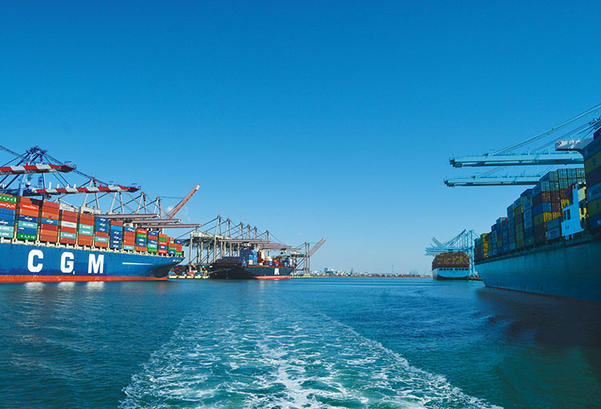(Note: Click here to see all articles related to the San Pedro Bay ports)
Between major shifts occurring in the shipping industry and President Trump’s vacillating rhetoric on trade, the outlook for international trade might seem foggy to the casual observer. But maritime and trade experts interviewed by the Business Journal have a solidly stable outlook for 2017, one that forecasts cargo growth at both San Pedro Bay ports.
The U.S. Consumer Confidence Index hit its highest level since 2000 in March. Higher consumer confidence typically means more expected purchases and, therefore, more imported goods coming through the nation’s ports.

(Port of Long Beach photograph)
“Consumers are buying, and industries are importing,” Ben Hackett, a partner in international trade consulting firm Hackett Associates, told the Business Journal. “We’re forecasting for 2017 . . . a 3.8% increase over 2016, which is about 22.2 million TEU [twenty-foot equivalent units],” Hackett said, referring to imports at ports in the United States as well as Canada’s ports in Vancouver, Prince Rupert and Montreal.
West Coast ports should experience a 3.7% increase in imported goods this year, Hackett said. While he expects the San Pedro Bay ports to experience about a 6% increase in imports in the first half of the year, growth in the second half should slow, resulting in an overall gain of 3.8% in 2017.
Capt. Kip Louttit, executive director of the Marine Exchange of Southern California, recently modified his budgeted outlook of ships arriving at the San Pedro Bay ports due to positive cargo forecasts. “Very happily, we are, as of today, 111 ships above where we should be . . . which is part of why we’re projecting 15 ships per month more moving forward into 2018,” Louttit said of ships arriving to the ports of Long Beach and Los Angeles.
The Marine Exchange is a more than 90-year-old nonprofit organization and public/private partnership with the U.S. Coast Guard that provides vessel traffic service to the San Pedro Bay ports. It is dedicated to ensuring efficient arrivals and departures of all vessels in the ports. With the exception of 2010 and 2011, the Marine Exchange has tracked decreases in vessel calls to the ports every year since 2008. In 2016, the tide turned when the ports experienced an increase of 196 vessel calls.
“The nice uptick of roughly 200 vessels between ’15 and ’16, I think, was [the result of] an improving, more optimistic economy,” Louttit said.
The reshuffling of the four alliances of major shipping companies into three alliances should not have impacts on the amount of cargo flowing through the ports this year, according to Hackett. The new alliance structure officially began on April 1.
“It won’t have any effect on volumes, but it will impact the terminals because the one thing we’re beginning to see is that they are focusing on trying to reduce the number of port calls,” Hackett said. Shipping companies are focused on reducing the number of deployed vessels but using larger ships, he explained. “What that does mean is that there is more being discharged in individual ports of call [at one time]. So that puts pressure on the terminals.”
Still, Louttit predicted an overall increase in vessels arriving at the San Pedro Bay ports this year.
“Everyone is asking” how the change in alliances is impacting the ports, Louttit noted. “And so far what we have heard and what we have seen is the ships are going to different terminals than they used to,” he said. “Whether they are going to then move between the ports will also be interesting to see.”
While President Trump has said in the past that he wants to renegotiate major trade agreements like NAFTA and perhaps institute policy changes to put America on a more even playing field with China, what actions he might actually take remain up in the air.
“There is no real action, traction or change due to the Trump administration threats of border taxes and tariffs and all the other things,” Hackett said. “In fact, after the meeting with China, all of that sort of went by the wayside, it seems to me,” he said, referring to Trump’s recent meeting with the president of China. With tongue in cheek, he observed, “All of a sudden, China is no longer a bad country in terms of currency manipulation. That terrible disastrous NAFTA trade agreement is no longer even being mentioned.”
Hackett added, “Who knows what’s happening in [North] Korea. But assuming that he can pressure the Chinese to control the North Koreans, it means there will be little or no action taken on Chinese imports or exports to the U.S.”
Despite uncertainty over the outcome of upcoming elections in Europe and ongoing wars in the Middle East, Hackett said, “I think, overall, this year the global trade and global economy will be fairly strong.” He added, “We’re seeing growth rates around 3% probably, in terms of trade – possibly going up to 4% at the global level. So all things being equal, 2017 should be a good year.”
